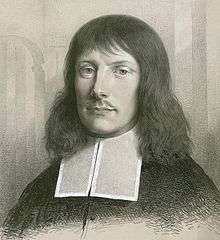Herr Gott, Beherrscher aller Dinge, BWV 120a
| Herr Gott, Beherrscher aller Dinge | |
|---|---|
| BWV 120a | |
| Wedding cantata by J. S. Bach | |
 Joachim Neander, author of the chorale text |
Herr Gott, Beherrscher aller Dinge (Lord God, ruler of all things),[1] BWV 120a,[lower-alpha 1] is a wedding cantata by Johann Sebastian Bach. He composed and first performed it in Leipzig, most likely in 1729.
History and text
Bach composed the cantata for a wedding in Leipzig probably in 1729, "in great haste", according to Klaus Hofmann, looking at Bach's handwriting and mistakes made by the copiers.[2] Only the vocal parts, a viola part and three continuo parts are extant. As the cantata shares music with other works, particularly BWV 120, but also BWV 1006 and BWV 137, it can be reconstructed.[2][3] The names of bride and groom are not known. He has been assumed to be a minister, deducted from the text "Herr, fange an, und gib den Segen / auf dieses deines Dieners Haus" (Lord, begin and pronounce your blessing / on this, your servant's house).[2]
The text was written by an anonymous poet.[3] It is in two parts, the second one marked Post copulationem (after the wedding ceremony).[2] The closing chorale is by Joachim Neander, stanzas 4 and 5 of his hymn "Lobe den Herren, den mächtigen König der Ehren".[1]
Scoring and structure
The piece is scored for four solo voices (soprano, alto, tenor, and bass) and a four-part choir, three trumpets, timpani, two oboes, two oboes d'amore, two violins, viola, and basso continuo.[4]
The work has eight movements in two parts: Part 1
- Chorus: Herr Gott, Beherrscher aller Dinge
- Recitative (tenor, bass, and choir): Wie wunderbar, o Gott, sind deine Werke
- Aria (soprano): Leit, o Gott, durch deine Liebe
Part 2
- Sinfonia
- Recitative (tenor and choir): Herr Zebaoth, Herr, unsrer Väter Gott
- Aria (alto, tenor): Herr, fange an und sprich den Segen
- Recitative (bass): Der Herr, Herr unser Gott, sei mit euch
- Chorale: Lobe den Herren, der deinen Stand sichtbar gesegnet
Music
Of the eight movements, only the three recitatives (movements 2, 5 and 7) are unique to this cantata. Bach parodied movements 1, 3 and 6 in 1730 in the cantata Gott, man lobet dich in der Stille, BWV 120b, celebrating the anniversary of the Augsburg Confession, and in a cantata for Ratswechsel (Inauguration of a new town council), Gott, man lobet dich in der Stille, BWV 120, which Hofmann dates 1742.[2] The respective movement numbers are 2, 4 and 1.
The second movement is in three parts: a secco bass recitative, a choral intervention, and a secco tenor recitative. The first part closes with a "florid" soprano aria in modified ternary form.[5]
Part II opens with a sinfonia which is adapted from the first movement Preludio of the partita for violin solo in E major, BWV 1006, and was in 1731 re-adapted for the cantata for Ratswechsel Wir danken dir, Gott, wir danken dir, BWV 29.[2] The following tenor recitative ends with a choral statement from a litany "Erhör uns, lieber Herre Gott" (Hear us, dear Lord God).[1] The sixth movement is a duet aria in da capo form. The bass recitative, "Bach at his most avuncular", prepares the closing chorale,[5] a setting which appeared as the closing chorale of the chorale cantata Lobe den Herren, den mächtigen König der Ehren, BWV 137, composed in 1725.[2]
Recordings
- Amsterdam Baroque Orchestra & Choir, Ton Koopman. J.S. Bach: Complete Cantatas Vol. 20. Antoine Marchand, 2003.
- Bach Collegium Japan, Masaaki Suzuki. J.S. Bach: Cantatas Vol. 51. BIS, 2011.
Notes
- ↑ "BWV" is Bach-Werke-Verzeichnis, a thematic catalogue of Bach's works.
References
- 1 2 3 Dellal, Pamela. "BWV 120a - "Herr Gott, Beherrscher aller Dinge"". Emmanuel Music. Retrieved 31 August 2014.
- 1 2 3 4 5 6 7 Hofmann, Klaus (2012). "Herr Gott, Beherrscher aller Dinge / Lord God, ruler of all things, BWV 120a" (PDF). bach-cantatas.com. pp. 8–9. Retrieved 1 September 2014.
- 1 2 "Cantata BWV 120a". Bach Cantatas Website. Retrieved 23 July 2013.
- ↑ "BWV 120a". University of Alberta. Retrieved 23 July 2013.
- 1 2 Mincham, Julian. "Chapter 77 BWV 120a". The Cantatas of Johann Sebastian Bach. Retrieved 23 July 2013.
External links
- Herr Gott, Beherrscher aller Dinge, BWV 120a: Scores at the International Music Score Library Project
- Gott, Beherrscher aller Dinge (uncompleted) BWV 120a; BC B 15 / Sacred cantata (Wedding) Leipzig University